#emperor valens
Text

Upon the decease of Valentinian, six days after his death the army in Italy proclaimed his son Valentinian, then a young child, emperor, at Acincum, a city of Italy. When this was announced to the other two emperors, they were displeased, not because the brother of the one and the nephew of the other had been declared emperor, but because the military presumed to proclaim him without consulting them, whom they themselves wished to have proclaimed.
Soc. 4.31
so valentinian ii was four years old, and ngl, I’d be annoyed as hell too lmao
(we’re doing a little bit of hollywood casting (so to speak) with the designs for the moment, it was subleyras’ painting of saint basil celebrating mass that caught my attention first, and while it vexes me, it also occupies my thoughts 24/7)
#emperor valens#emperor gratian#it’s personally funny to me if gratian is the same height as valens @ age 16. we have a million grievances and his nephew ending up taller#than him can be another one#drawing tag
124 notes
·
View notes
Text

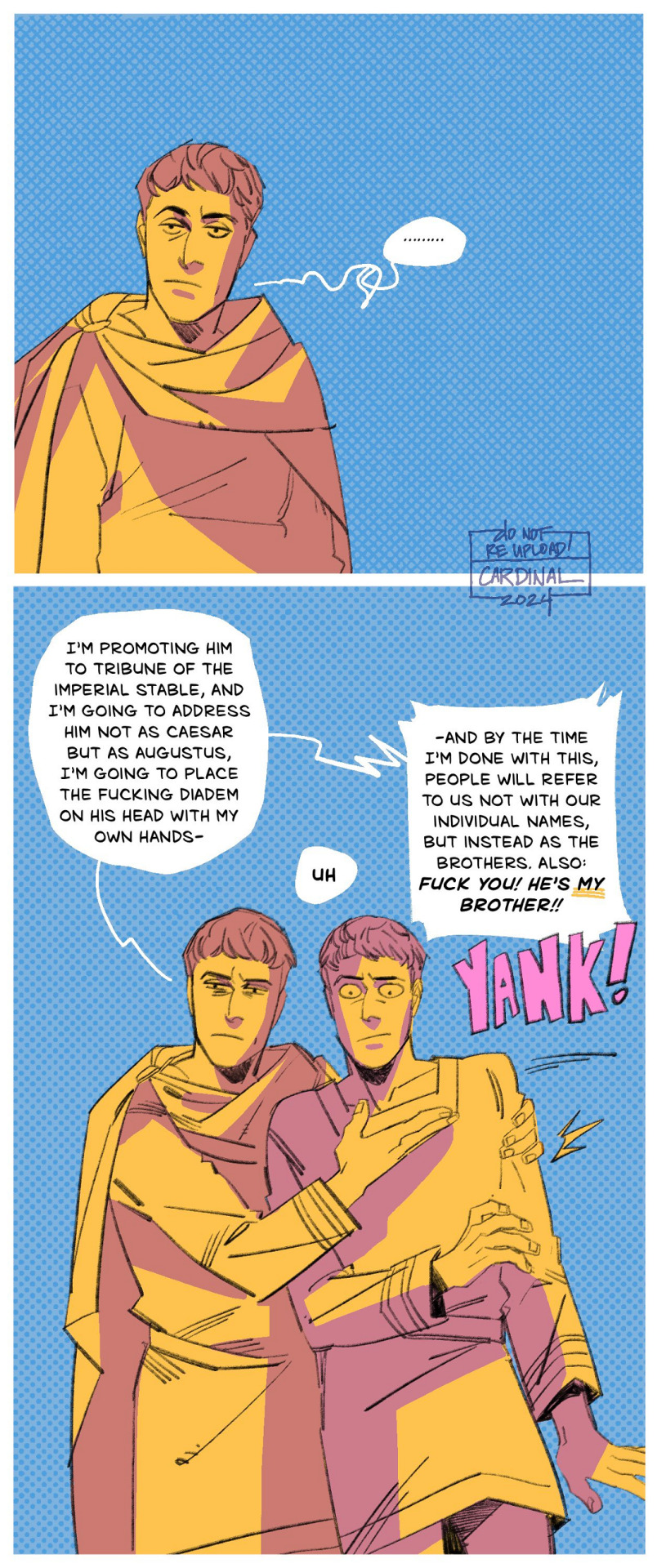
Now Valentinian was chosen emperor in Bithynia (as we have said before). He gave the signal for the march for the next day but one, and assembling the chief civil and military officials, as if ready to follow safe and sound advice rather than his own inclination, inquired who ought to be chosen as partner in the rule. [...] Dagalaifus, at that time commander of the cavalry, boldly answered: "If you love your relatives, most excellent emperor, you have a brother; if it is the state that you love, seek out another man to clothe with the purple." The emperor, angered by this, but keeping silence and concealing his thoughts, forcing the pace, entered Nicomedia on the first of March, and appointed his brother Valens chief of his stable with the rank of tribune. Then, on his arrival in Constantinople, [...] on the twenty-eighth of March he brought the aforesaid Valens into one of the suburbs and with the consent of all (for no one ventured to oppose) proclaimed him Augustus. Then he adorned him with the imperial insignia and put a diadem on his head, and brought him back in his own carriage, thus having indeed a lawful partner in his power, but, as the further course of our narrative will show, one who was as compliant as a subordinate.
AM 26.4.1-4
there's some hint of 'no one's allowed to talk shit about my brother but me,' energy, but also generally I'm just kind of obsessed. not with Valentinian I, but with Valens. hello.
I'll probably get into Valens later, since he's taking up a significant amount of room in my thoughts, but for now, it's the 'oh! the brothers were co emperors!' that's making the wheels spin. (the last time I was reading about brothers, or people made to be like brothers, as co-rulers, it was with Tiberius. and that goes about as well as you expect it to lmao)
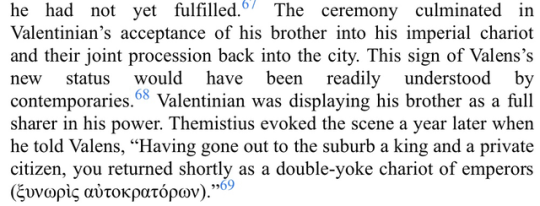



Failure of Empire: Valens and the Roman State in the Fourth Century A.D, Noel Lenski
⭐ I have a tip jar (ko-fi)!
⭐ and other places I'm at! bsky / pixiv / pillowfort /cohost / cara.app
#roman empire tag#komiks tag#there's that one painting of saint basil celebrating mass and valens looks SO hot in it. it's actually a little baffling. like.#what's up with that. but what's important is that i immediately got obsessed and had to look him up and now i'm speed running#what happened with crassus only there are no real life dead people involved with that arc#long post#rip tiberius you would've loved to know that there was indeed a pair of brother co-emperors#you probably would've tried to force them into twin roles if you could.#later Roman Empire tag
155 notes
·
View notes
Text





valen's apartment: complete
#ts4#ts4 interiors#oc: valen#anyway i'm gonna go play bg3 until i have to clock in#giggling at the squid as a lil tribute to the emperor. sorry we hit it and quit it king
175 notes
·
View notes
Text
new desktop theme! mostly because tumblr only does super tiny icons right now RIP, so I made the sidebar image a close up of my new icon: it's the roman emperor valens from subleyra's the mass of saint basil :)
#mostly because i think the posing of his body is super hot#like do not worry i am not about to start preaching catholicism to you unless it's spectacularly horny. this is abt valens#i have more to say about confessionals and communion#but oooooooh a neck exposed at a vulnerable angle like that. fun! love it!#also very obsessed with valens from a vague point of 'oh you had a (redacted) dynamic with your brother huh.'#nothing changes in the roman empire for real and also you cannot escape the visuals of the late republic motherfucker!#like what century armor are you WEARING and also absolutely banging decision to make valens of all people wear that#in a painting. love it!#anyway don't let people on my other blog know that im secretly a little obsessed with a later roman emperor#i have a reputation to maintain as not caring about anything past caligula#(redacted for no particular reason it'd just take too long to explain house hold structures and large scale politics#and also the sforza family of all people. etc.)
19 notes
·
View notes
Text
updating the list of names I'll answer to on my other blog without providing any kind of context feels like tradition at this point
#i'll tell you guys tho bc it's not like. a big deal. literally it's just how i sign letters i send to a friend#we both go thru names like clothes through a washing machine but i sign off with jester more often than not now bc its fun#tbh i should take valens off and replace it with shades or sunglasses but valens is fun#me 🤝 valens: being way out of our depths#also it's following in tradition of all those old ancient rome forums where people picked a roman name lmao#i decided if i had to pick one i'd go for an emperor BUT i picked the one that everyone considers a fuck up so it balances out
3 notes
·
View notes
Text
i think the other legates would have torn valens to shreds
like im glad he didnt win his little weapons gambit but i would have paid money to see him step foot in the capital and see all thirteen other legates turn slowly and look at him with who is this clown expressions
#legate on legate violence#like okay im sure given the state of the empire that at least a couple of the other legates are idiots but. i think anyone who has spent#more than five minutes playing the high level political game that is Controls Countries#would have a field day peeling valens skin off#i think he is alive because he runs his little game in the middle of nowhere#you know what i also would pay to see zenos turn this man into a toothpick#is he too bored to tears to engage? yes. will valens eventually in his lust for absolute power over the empire do something stupid and try#to dispose of zenos at some point#oh. oh i was THERE to here the way he talked about zenos i KNOW he would#wouldnt even wait#and then zenos would mash him like a banana#ffxiv#the sorrow of werlyt#''im gonna be the emperor!!!' uh huh#WAIT. ITS FANDANIEL WITH A STEEL CHAIR#fcuk legate on legate violence how about clown on clown
4 notes
·
View notes
Text
Historical Rundown:
From East, To West: (Before Imperial History)
The forebears of the majority of men and elves on the continent of Cierpienie, emigrated westward from Oniria, in the face of a threat to their way of life - in the form of the Pointed-Heel Clan, a cult dedicated to the God of Destruction, Domination, Determination, and Willfulness, Gniewnybog.
These emigrants were met with curiosity, upon the easternmost shores of Ladowanie, by the great and diminutive Gleboki and Cichycien, the most prominent natives of Cierpienie.
These emigrants spread through Ladowanie, expanding westward into the forests, hills, and plains of the Heartlands, which would later become known as Serce.
As nature hates a vacuum, the inevitable happened, and petty warlords and squabbling fiefdoms sprang up and seized power, making helpless chattels of humble frontiersmen, farmers, and craftsmen alike.
Centuries passed, and a slave revolt in what would later become the Imperial Capital of Bezstrachu, spurred on the War Of Expansion; a series of preemptive strikes against the other slavemasters and warmongers that surrounded the revolutionaries on all fronts.
By the end of the war, Valen Draconis was formally crowned as Emperor, and the Sercean Empire was forged from the blood of the wicked masters who had ruled unjustly before.
From West, To East: (Subsequent with the War of Expansion)
To the west, is a Twin isles region, where the haughty Greater Elves, the crafty Lesser Elves, and a second sect of pureblooded Men existed for many centuries in their own niches, before making contact with one-another.
Intermingling so thoroughly, the unity of these three ancestor races, birthed the Half-Elves; a descendant race of such genetic diversity, that any number of ancestral traits could manifest in a child.
House Valtekar, and most of the Greater Elves despised the Half-Elves, seeing them as an insult to their supremacy; after all, how could ANYONE be smarter, stronger, or more clever than a Greater Elf? Impossible!
Lo, Valtekar propagandized, and pushed forth a vitriolic eugenicist movement, that saw the Half-Elves barely tolerated at best, or persecuted and murdered at worst.
Lyprios Trentius, a small political figure and humanitarian, sought to relieve his people of their suffering, but knew they could not formally make overt moves against Valtekar without incurring the wrath of the other Ruling Houses.
Those that followed his word, fled to the east by ship, sailing to Cierpienie; though a storm had separated a small handful of craft from the larger emigrant fleet.
Landing in the southwest, in what would later become County Cardell in Serce, Lyprios and the surviving Half-Elves built up a community in this empty territory.
Prior to this mass exodus, Lyprios had unknowingly contracted Porphyria Maledictus - known in the West as Vampire's Disease.
Hiding this from his people - out of fear of appearing weak - Lyprios sheltered himself during the construction of the Half-Elves' first colony.
Unable to cope with the physical and mental stress of his changes, Lyprios' noble intentions became twisted, the darkness in his mind running so deep, that he had begun turning this hapless colony of refugees, into a cult of personality, dedicated to himself.
Progressively, more and more Half-Elves accepted the Night's Sanguine Blessing, pledging themselves to Lyprios, and the Bloodfeast.
This Vampiric War-Cult became something of a danger and a nuisance over the years in which it had persisted.
Members were sent out upon their master's command, to pillage, plunder, and harvest; riches, materials, and blood, all in the name of Lyprios Trentius.
The reign of Lyprios came to a pathetic end, as the cult leader was slain in his sleep, by his own son, who would later take the name Thanatos. The would-be Blood-Prince laid waste to the township in which the War-Cult had resided, leaving none alive, save for himself, and betrothed, Drevina.
The Cult had grown far too greedy and confident; earning the attention of the then-growing Bezstrachu Revolutionaries.
If the two factions came to blows, none would be able to stem the wrath of their Dark Master.
In his betrayal of his own people, Thanatos had silently pledged himself to the people of Cierpienie, refusing to allow such evil to spread unrestrained.
For his efforts, the former prince was not executed, but pardoned and rewarded.
From the coffers of the old masters, later reformed into the Imperial Commercial Treasury, Thanatos was granted a new home, to the east in Everwatch County; a fortification, carved into the side of one of the great Cardius Mountains.
Conclusion:
From the conclusion of the War of Expansion, to the formation of the Empire proper, Imperial History began.
Year 0, of the First Age of the Empire (stylized as 1A, 0), marked a new beginning, which would span into the Third Age, over the course of 7.500 years.
In this time, many great mysteries were unraveled, great tragedies unfolded, and tremendous victories and acts of beauty spread outward into the world.
#cierpienie the great isle#fantasy worldbuilding#fantasy history#world building#Lyprios Trentius#Thanatos Trentius#Drevina Trentius#Emperor Valen Draconis#Bol'Dolor Oniria#Bol'Dolor Cierpienie#Bol'Dolor Western Isles#fantasy world
1 note
·
View note
Text
ON THIS DAY, 364 AD
VALENS is made East-EMPEROR alongside his brother VALENTINIAN I
👑

#history#ancient history#classics#ancient rome#meme#roman#memes#valens#roman emperor#roman empire#adrianople#history memes#rome memes
1 note
·
View note
Text
Werlyt in Lorebook 3
So Werlyt gets a page expanding on its location and history a bit, to be expected as the new Encyclopaedia Eorzea 3 goes over both Shadowbringers and Endwalker content. What they do with its history as an Imperial province again paints Gaius in a better light...in ways we already knew were IC for him as established in earlier content, while also being straight up out of Machiavelli's The Prince in a way that makes complete sense for the Empire when dealing with conquered provinces, and how we've even heard before how some of them are ruled very much like native Garlean regions.
See, one of the oldest tricks in the literal book is you conquer a province, and especially if it proves unruly, you give it a nasty governor. Use them to root out the rebellious factions, while also tearing apart the old systems, stripping resources, crushing the populace, etc. THEN you send in a Reasonable Guy to take over who ousts the bad vicious leader, restores order, treats the people well, and so on. Now that new governor--and by extension his emperor for sending him--looks better in the eyes of the people, a problematic political/military rival has been killed/broken politically, the unruly elements have already been culled, and the people are just grateful for a reprieve from their misery. More acquiescent and "this isn't so bad after all."
Another famous literary example (and with a new movie a few months out) is Dune; once Harkonnen takes back Arrakis, he sends one nephew, Raban, who is literally nicknamed "the Beast", to be a horrible bully of a governor. His job is to root out the remaining loyal Atreides and quash the local Fremen. Then once Raban's atrocities were at their peak, Harkonnen meant to send in his heir, Feyd-Ruatha, to be the golden prince who would get rid of the problematic Raban (lethally if needed) and be accepted by the people as a decent leader. Of course, Dune's story rolls out differently, but the play is the same.
The Garlean Empire did the exact same thing in Werlyt.
For 30 years the subjugated nation was oppressed and stripped of resources. When the Empire's attention moved toward Othard and the military presence thinned enough a rebellion rose up, it was still crushed, but not before the previous viceroy was killed in the revolt.
Then Gaius van Baelsar came in and restored order. We already knew Gaius had a habit of appointing the right people for the job, regardless of race and social standing; he continued that in Werlyt, and was otherwise a good governor, working to ensure the populace was cared for, administered properly, even improved education and literacy rates. So after a few decades of crushing abuse...now Werlyt had a "reasonable governor" who treated them like people and took care of them, if still under the auspices of the Empire. They made it look like a better deal, and the previous guy was a mistake that shouldn't have happened.
This also tracks with pre-Praetorium Gaius as the "true believer" of Garlemald's Imperial mission of taming the "savage" lands and ushering them into the "civilized" ways of the Empire and adding those peoples' knowledges, cultures, skills, and might to the Empire to make everyone better. That "unity" aspect he and other leaders like Quintus van Cinna spouted while missing the hypocrisy. Gaius was a good governor because he thought that was the entire point--and then also led to his opposition of the Meteor Project. He never wanted to wipe Eorzea out, he wanted to bring it under Imperial control and govern it as he had Werlyt.
So for twenty years, Gaius was the reasonable governor getting good grades in cultivating Werlyt as a respectable and flourishing province of the Empire. Then he was sent to Ala Mhigo to conquer that, and through it the rest of Eorzea.
...And then Valens van Varro took over Werlyt and pretty much overnight undid everything reasonable a decent governor would do because of his jealousy over Gaius and his own ambitions for power, especially after the civil wars left the Imperial throne vacant. Also cuz again, they have to spend this branch of story making Gaius look better by making Valens cartoonishly bad at everything. Rather than trusting what they already wrote about a complicated man who truly believed in his mission until forced to see how he had been a pawn sowing misery his whole life. But they've tended to rewrite Gaius and his on screen characterization a lot as it is, and with Garlemald not getting an expansion of its own (they had considered it but ultimately worked its fall into ShB and EW), it feels like they hammer this point in Werlyt to speed run what was supposed to be an actual rehabilitation arc for the character.
And then it once again frames the quintent as rebellious heroes who thwarted Valens plans to use them and the Weapons project for his own ends and sure we'll let that go cuz the folks in Werlyt need something. They do have a named leader (Talbot Hunte) and a government set up and none of it really mentions Gaius, though we know they put him in charge of their military. Cuz yeah, he was one of their conquerers--but they also know that they can work with him and that he knows how to run an army effectively.
Also all the quintet are literally named "aan Baelsar" in their entries, though the main thing I noticed there was that Milisandia did in fact dye her hair red to account for the discrepancy in her child appearances in the various flashbacks. Apparently it was cuz she noticed Alfonse seemed very fond of one of their caretakers at the orphanage, and so Milisandia changed her hair to be the same color to try and get his attention, quietly pining for him for years but never letting him know about her not-quite-sisterly affections.
#final fantasy xiv#encyclopaedia eorzea#lorebook#sorrow of werlyt#gaius baelsar#shadowbringers#endwalker
65 notes
·
View notes
Text




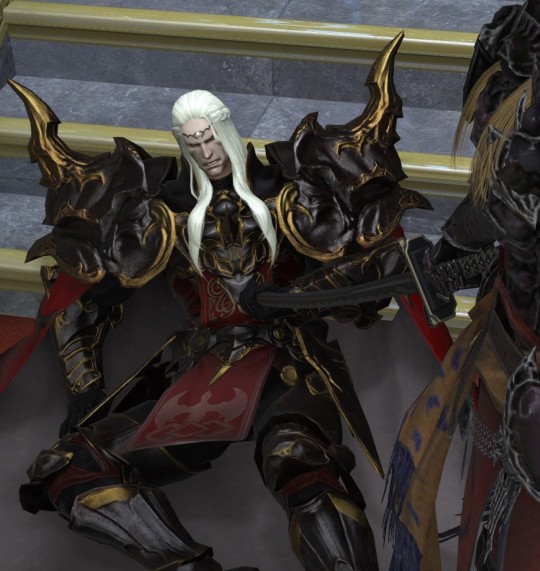




The realization that despite fighting the Garlean Empire through two iterations of the Final Fantasy XIV base game and four expansions, the Warrior of Light has never killed a standing Legatus.
Nael van Darnus, Legatus of the VIIth - defeated in the Coils of Bahamut raid but finished off by Louisoix (at the behest of the primal Bahamut).
Gaius van Baelsar, Legatus of the XIVth - never killed.
Regula van Hydrus, Legatus of the VIth - killed by the primal Zurvan.
Zenos yae Galvus, Legatus of the XIIth - defeated at Ala Mhigo but ultimately commits suicide. Comes back to life but is stripped of his status in Garlemald society before he is killed again.
Former High Legatus Varis zos Galvus, Emperor of Garlemald - killed by Zenos.
Noah van Gabranth, Legatus of the IVth - never fought and is dubiously 'killed' in Bozja epilogues.
Valens van Varro, Legatus of the VIIth - popped like a grape by the Diamond Weapon controlled by Alphonse.
Quintus van Cinna, Legatus of the Ist - commits suicide after the failure to counter the Ilsabard Expeditionary Force.
Vergilia van Corculum, Legatus of the IIIrd - never killed.
I considered adding Solus zos Galvus/Emet-Selch to the list but frankly he's so far removed from his status as legatus after his long reign as Emperor, death and subsequent return as the secret power behind the throne that his one-time status as legatus is more a piece of trivia. The Warrior of Light also technically fights and kills Nerva Galvus, but his status vis-a-vis the royal family is dubious and he's become a blasphemy by the time he's fought anyway.
As such it means the highest-ranking, active-service Garlean officer the Warrior of Light has ever killed in battle is...
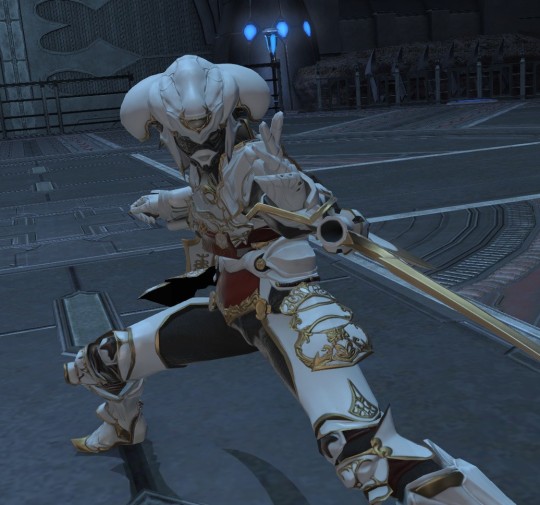
Livia sas Junius, Tribunus Angusticlavius of the XIVth - killed at Castrum Meridianum during Operation Archon
(Menenius sas Lanatus is equivalent rank, but the IVth has definitively abandoned Garlemald by the end of Bozja, so whether he counts is open to interpretation.)
34 notes
·
View notes
Photo
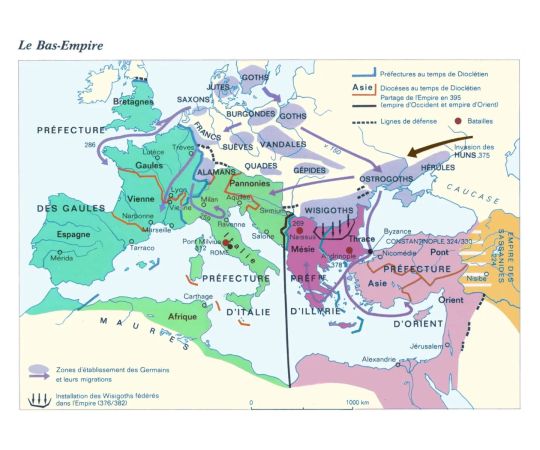
The Lower Empire
« Atlas historique Larousse » sous la direction de Georges Duby, édition revue et corrigée, 1987
by cartesdhistoire
In the 3rd and 4th centuries, the Empire faced a triple threat: to the north, the Germans, numerous, unstable, and warlike, pressed on its borders; to the east, the Sassanid Persians, victorious over the Arsacid Parthians, constituted the only organized state opposing Rome; in the south, the Saharan nomads posed the least dangerous threat. The crisis reached its peak from 256 to 269, when these enemies coordinated their attacks. However, from Claudius II (268–270) to Diocletian (284–305), the Illyrian Emperors managed to stabilize the situation, despite significant challenges (such as the Alamanni and Franks invading Gaul in 275). At times, they negotiated deals, notably with the Sassanids. In 332, the Goths from the lower Danube, defeated, agreed to an unequal alliance treaty with Constantine. In exchange for subsidies and the right to trade with Rome, they pledged to provide troops to the Emperor upon request. They remained loyal to the Constantinian dynasty thereafter, supporting Constantius II against Magnentius in 351-353 and backing the attempted usurpation of Procopius against Valens in 365.
Constantine organized the first universal council in 325 at Nicaea, bringing together bishops to achieve theological unity within Christianity. Some external bishops (Persians and Goths) attended, and Constantine, as Roman Emperor, presented himself as the natural protector of Christians worldwide.
Constantine's establishment of Constantinople as the second capital shifted the empire's center of gravity (331). Constantine's three sons succeeded him, and after several episodes of civil wars, Constantius II (337-361) emerged victorious from the conflicts. He imbued power with a hieratic, sacred, and Christian character.
However, stabilization primarily came from the reorganization of the army (stationing fixed units at the borders and maintaining a mobile reserve at the rear), leading to victories over Persians, Goths, and Franks, ensuring half a century of tranquility. This peace was reinforced thanks to the resolute character of Valentinian I (364–375).
41 notes
·
View notes
Text

Saint Gregory Nazianzen
Doctor of the Church
329-390
Feast Day: January 2
Patronage: for harvests, poets
Saint Gregory Nazianzen is from a family of saints, was baptized at 30, ordained a priest reluctantly at 32, and bishop at 41. During the reign of Emperor Valen, an Arian supporter, St. Basil, his lifelong friend asked him to rebuild the faith in Constantinople, an Arian stronghold. ( Which denies the divinity of Jesus Christ, believing Him not to be co-eternal with the Father.) He started renewing the faith by giving sermons on the Trinity at great suffering, slander, insults, and even personal violence to himself. Today he is simply known as “The Theologian.”
Prints, plaques & holy cards available for purchase here: (website)
44 notes
·
View notes
Text
sforzesco ➡ brother-emperors
briefly, entering my brother-emperors url era! we will be returning to sforzesco in the future because I only care about three roman emperors, but the sforzas are forever
#if there was a good crassus url i'd do that but alas.#the roman emperors are caligula. valens. and theodosius. and the last two are because of the sexy subleyras paintings only now it's#getting kind of serious. I’m also eating books on the Byzantine empire. lots of good stuff here. delicious.#saw a text abt how people think Byzantine architecture is ugly and it made me sad :( I like it :(
48 notes
·
View notes
Text

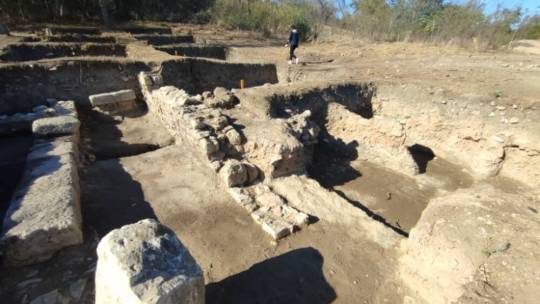
Archaeologists Discovered Roman Floor Mosaics in Bulgaria
Archaeologists discovered floor mosaics with early Christian designs and nearly 800 artifacts in the archaeological reserve of Marcianopolis in Devnya, in the northeastern part of Bulgaria.
The Roman town of Marcianopolis (present-day Devnya) in northeastern Bulgaria appears to have originated as a Thracian settlement. It was later inhabited by Hellenized settlers from Asia Minor and named Parthenopolis.

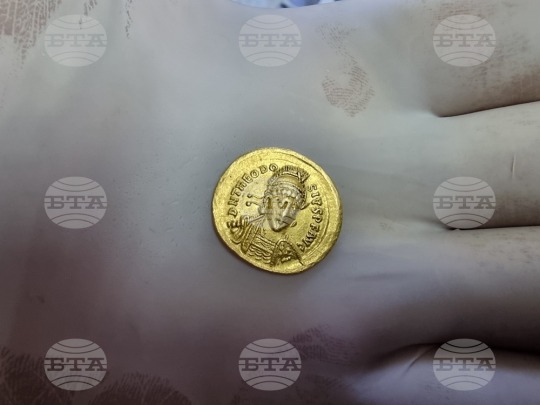
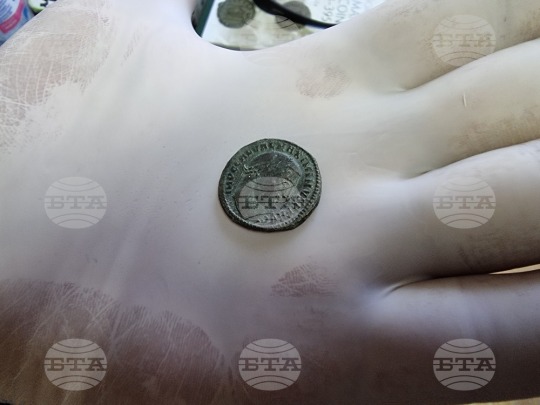
Roman Marcianopolis was established around 106 CE, following Trajan’s campaigns in Dacia to the north. The settlement was named after his sister, Ulpia Marciana. At the crossroads between Odessos (modern Varna), Durostorum, and Nicopolis ad Istrum, as well as the location of plentiful springs, Marcianopolis became a strategically important settlement.
Diocletian’s administrative reforms in the late third century CE divided Moesia Inferior into Moesia Secunda and Scythia Minor, with Marcianopolis serving as the former’s administrative capital. Marcianopolis experienced its most prosperous period during the middle of the fourth century CE. From 367 CE to 369 CE, the eastern emperor Valens used Marcianopolis as his winter quarters during campaigns against Visigoth incursions in the region. During this time, it served as the Eastern Empire’s temporary capital.

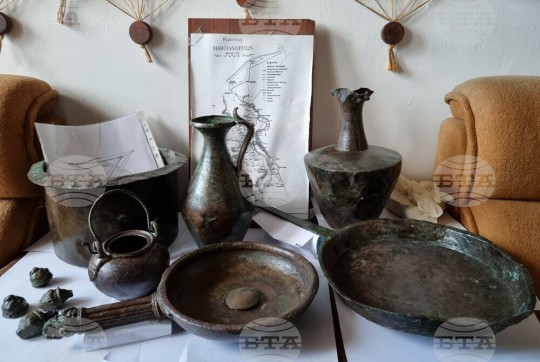

Floor mosaics with early Christian designs were found in the remains of a building. Archaeologists are not yet sure whether it was a public building or it belonged to a rich Roman citizen.
The tentative dating of the mosaics is in the first half of the 4th century AD.
The finds from the current archaeological season in Devnya contain another thousand bronze coins, several clay lamps and two clay vessels, which are awaiting scientific processing and restoration.
During the past archeological season, researchers restored bronze vessels discovered in the 1990s in a brick-walled tomb dating to the late 2nd – early 3rd century.
The vessels had a ritual use and were related to the personality of the person buried, Mosaic Museum director Ivan Sutev said in a statement to BTA.




They are richly decorated and the workmanship is exquisite, he added. The find includes a vessel for pouring liquids as offering to a deity, and a wine jug with a trefoil mouth (oenochoe). A simple kitchen pan was also found along with these. All this leads archaeologists to suggest that a Roman citizen of Marcianopolis may have been laid to rest in the tomb, but that he may have had more specific functions: a soldier, a cook, or even a priest, Sutev said.
Pottery that was discovered in the basilica’s environs during excavations in 2023 has since been restored. Among these are a mortarium vessel for liquids and an exquisite crater-shaped pot for liquids. These were located in the structure with the mosaic floors. Coins from the time of Emperor Theodosius II were also found scattered on the floor.
In 447, Attila’s Huns captured and destroyed Marcionopolis after conquering the entire Balkan Peninsula but failing to capture Constantinople. That is determined by 20 gold coins scattered on the floor of the building being studied. On one side of the coins is an image of Theodosius II, while on the other is the patron goddess of Constantinople. Among the coins discovered during the Marcianopolis excavations were those from the city’s founding in the second century. The latter are dated to the sixth century, around the time of Emperor Justinian.
By Oguz Buyukyildirim.
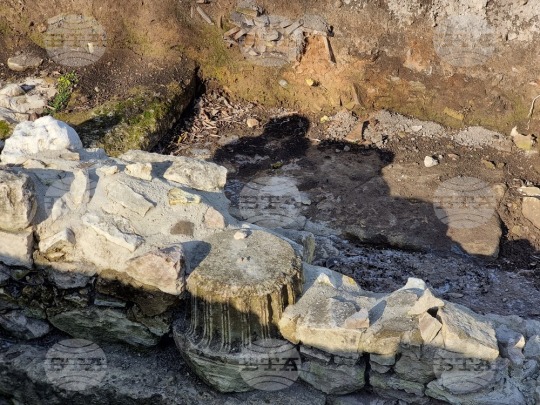
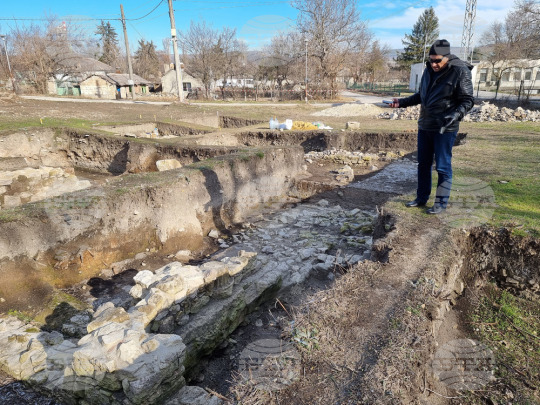
#Archaeologists Discovered Roman Floor Mosaics in Bulgaria#The Roman town of Marcianopolis#gold#gold coins#roman gold coins#ancient artifacts#archeology#archeolgst#history#history news#ancient history#ancient culture#ancient civilizations#roman history#roman empire#roman art#Emperor Theodosius II
44 notes
·
View notes
Note
I love your new icon! Is the person above the emperor a historical figure? The contrast between the two is a little creepy, I love it
not as far as I’m aware of! It’s part of a larger scene involving Saint Basil, the other guy in my icon is just catching Valens as he faints!
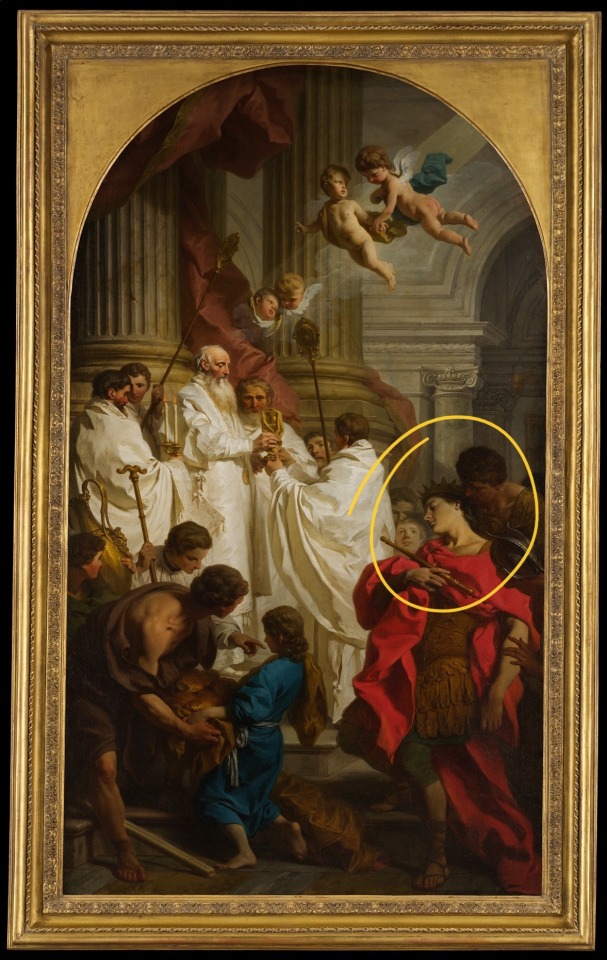
it’s actually a little funny to me that Valens looks so young here compared to Basil because Basil and Valens were born around the same time, and died within the same year of each other
#honestly I feel like art about Basil and Valens should be hornier in a hostile kind of way#power dynamics. theological differences. the clusterfuck Julian left Valens to deal with. that one moment of gentle overlap#and then bitterness once more! etc etc etc.#I’m normal about Valens I’m normal about Valens I’m normal about Valens (I’m not)#ask tag
32 notes
·
View notes
Text
Babylon 5 S03E17 War Without End: Part Two
previous episode - table of contents
Emperor Londo of the Great Victim Complex.
And so the fall of Babylon 5 begins, with two idiots deciding to take on Ivanova!
DUDE sick fight moves by Susan Ivanova. And Marcus must be internally fist-pumping that he pulle off a drop-out-of-the-ceiling attack. Style points: 1 Marcus, 100 Susan.
Zathras sees all. Zathras knows all. Poor Zathras.
Oooooooo. Future John and Delenn have a baby! How exciting. Delenn calls Sheridan's time "so many years ago" and references the "terrible, terrible price," That's something for me to chew on. I wonder if it will be revealed this episode or is foretelling for the season 3 finale or even later. I am really not sure how the pacing on B5 goes or if they'll still be fighting the Shadows into season 5.
The Shadows are only visible when they sleep? That's cool and unsettling information, but I'm not sure how that tracks with Londo's next reveal, which is that he is also possessed? So perhaps Londo tries to turn on the Shadows at some point and is leashed instead.
G'Kar!! Down an eye and plus a sick leather patch. Must be time for Londo's death vision! I hope G'Kar gets to live to enjoy it. Londo caused a lot of death for the universe and the Narnuan people. Aww and then he didn't. I am a bit bummed that G'Kar's end appears to be with Londo, dying together as the Shadow possessing Londo kills G'Kar back. It is pretty punk rock of G'Kar, though. Who else has choked a shadow-possessed Centauri emperor before?? No one except G'Kar of Narn.
Right before Sheridan is pulled away, she tells him not to go to Zha'dum, but all these prophecies seem to be self-fulfilling and an inescapable part of the paradox.
Uh-oh, why's that spacesuit doin' stuff. Ah. Never mind, it's a "yeah, Sheridan's back!" Someone slap a time stabilizer on him before he gets yote into the timestream again.
And there goes the theft of Babylon 4!! Time heist!
There goes Sheridan. Shoulda put a time anchor on him!
Revised Sinclair prediction: his aging as they move towards their own time aging him is the/a reason why he gets the ole Minbari physical transformation since Minbari live so much longer, to extend his lifespan.
Oop, Sheridan's back again. Or the space suit he was wearing is, at least.
Yeah Susan Ivanova. she can do anything. Ivanova has B4's command station.
Delenn in the blue spacesuit?? Plot twist!!
Hmmm, so some of what I thought Sheridan was going to do (fight 1000 years in the past) is actually Sinclair's plot. That makes more sense, actually.
Zathras makes it all very clear: "You (Sinclair) are the one who was. You (Delenn) are the one who is. You (Sheridan) are the one who will be."
Babylon 4, A Thousand Years Ago
Valen?? Sinclair has always been the prophet Valen!! I did not see that coming. What an entrance! Appearing to Minbar flanked by two Vorlons, arriving in a vast space station in a flash of tachyons...Sinclair is Valen. fuck, that's cool.
Next!
#jeffrey sinclair#war without end#minbari#delenn#john sheridan#susan ivanova#marcus cole#londo mollari#g'kar#woodsfae b5#babylon 5
14 notes
·
View notes